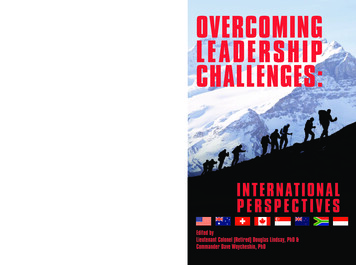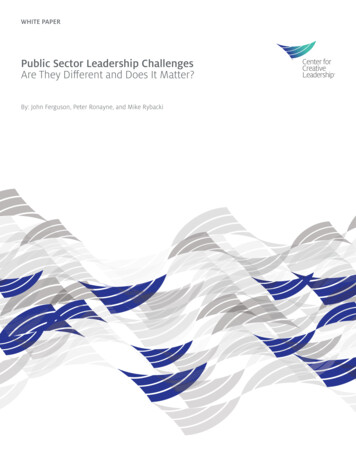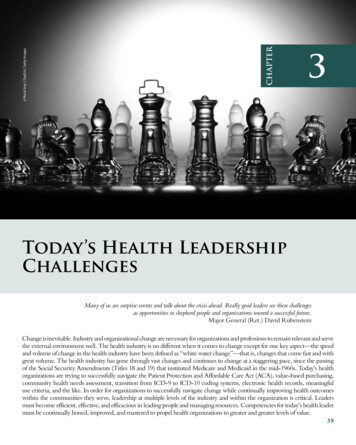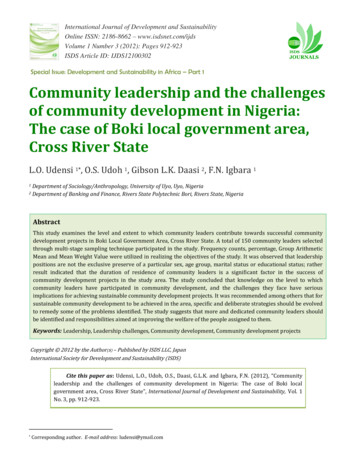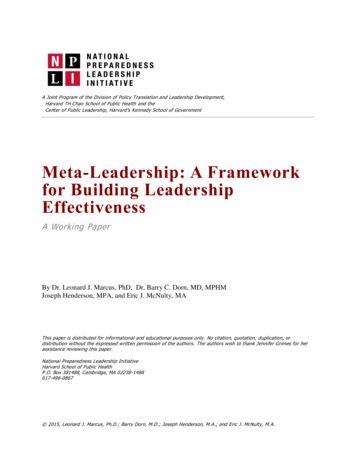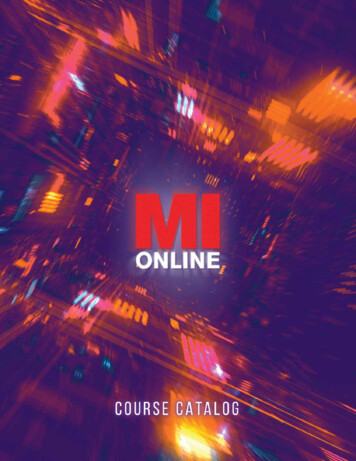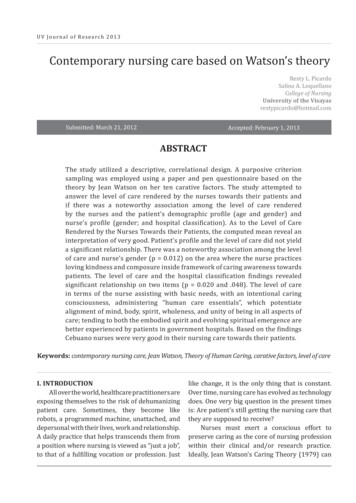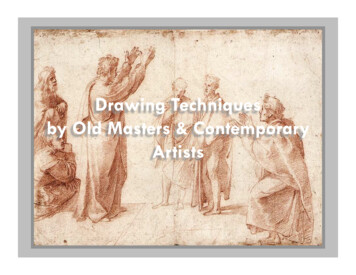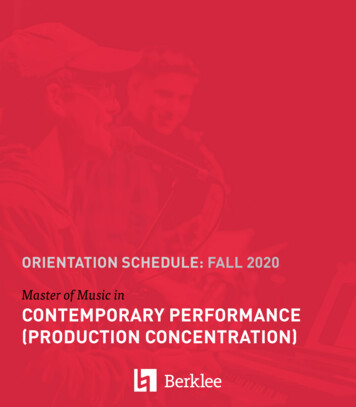
Transcription
Contemporary LeadershipChallenges:Talented Organisation for Talented PeopleAuthor:Alexandra SivenkoTutor:Dr. Philippe DaudiCo-tutor:Dr. Mikael LundgrenProgram:Master’sProgrammeinLeadership and Management inInternational ContextSubject:Methodology & Thesis ProjectManagementUmbrella theme:Breeding and nurturing talentsLevel and semester:Graduated, spring 2008Baltic Business School
Contemporary Leadership ChallengesAbstractThe globalisation of economy, increase of employees’ mobility, the forthcoming shortage of peoplenext 10 years and, hence, war for talented people are some of the most important problems ofcorporations today. This thesis has a purpose to show systematic picture of the organisation, whichwill be named as Talented Organisation, with appropriate conditions for having talented peoplewithin and developing their talents.Some assumption of the research discussed in this paper are about the talented people themselves asspecial, difficult to work with, but interesting for any organisation. They can create some problemsfor leadership and co-workers and at the same time represent the most important source of ideasand to be essential resource.It will be described the strategy for gaining the Talented Organisation which will facilitate theprocess of hiring talented people as well as will promote the utilisation of inner organisationalpotential: identifying, breeding, nurturing and retaining of talented people.Keywords: Talented people, Talent Management, Knowledge-Driven Organisation, Learning Organisation,Talented Leadership, Talented Organisation.iii
Contemporary Leadership ChallengesThis thesis dissertation is dedicated to my dear parents, grandparents, sisters Olga and Natalia andmy little godson Ivan.Alexandra SivenkoKalmar, Sweden, May 2008v
Contemporary Leadership ChallengesAcknowledgmentsThe inspiration to have research in chosen area has been given to me from Dr. Philippe Daudi,Head of the Master's Programme in Leadership and Management in international context ofUniversity of Kalmar, subsequently my tutor for the master thesis. Once we had a discussion duringthe class about the sad fact that people are seldom utilise their potential. The matter for leadership isto find the way how to help people to express their talents. It was the first step on a way to finalthesis. Many thanks for Dr. Daudi that generously have been sharing the knowledge, inspiring inevery possible way and supporting throughout all research. I want also to thank to Dr. MikaelLundgren for his constructive criticism, feedbacks and advices during the thesis preparation. Hehelped ver much do not to lose the focus and right direction of the research.I cannot leave without attention the contribution of my family in this research. I would like to thankthem for supporting me even if they are very far from Sweden. Their understanding andencouragement was very important for my study in Baltic Business School. I have been feeling theirbelief in me and this feeling gave me forces and enthusiasm.Kalmar, Sweden, May 2008vii
Contemporary Leadership ChallengesTable of contentABSTRACT . IIIACKNOWLEDGMENTS . VIITABLE OF CONTENT . IXTABLE OF FIGURES . XI123INTRODUCTION . 11.1THE RESEARCH AREA .21.2THE RESEARCH PROBLEMS .31.3THE RESEARCH QUESTION.51.4THE IMPORTANCE AND A PURPOSE OF THE STUDY.6METHODOLOGY . 92.1THE PROCESS OF THE RESEARCH .92.2THE APPROACH FOR DATA COLLECTION . 112.3THE GROUNDED THEORY (STRAUSS, A. AND JULIET CORBIN, 1990: 9) . 11THEORETICAL FRAMEWORK . 153.1BAY-IN STRATEGY FOR TALENTED PEOPLE . 153.1.1Hiring strategy . 153.1.2The corporate culture and reward system for attracting talented people . 163.1.3Key points . 193.2IDENTIFYING, BREEDING, NURTURING AND RETAINING TALENTED PEOPLE WITHIN THEORGANISATION . 203.2.1Identifying talented people . 203.2.2Breeding, nurturing and retaining of talented people . 213.2.2.1 The suitable talent management approach . 223.2.2.2 A plan for gaining new talent management approach . 233.2.2.3 Knowledge-driven culture for talented people . 253.2.2.4 Learning organisation for developing talent . 263.2.2.5 Five disciplines of Peter Senge for achieving learning organisation . 273.2.3Talented leadership for talented people. 313.2.3.1 Three leadership roles in the learning organisation for talented people . 313.2.3.2 Leading innovative learning in the organisation . 32ix
Table of content3.2.44Key points . 37ORGANISING FOR TALENTS AND TALENTED ORGANISATION . 394.1TALENTED PEOPLE . 394.1.1Main characteristics of talented people . 394.1.2Talented people‟s needs and expectations . 414.1.3Key points . 424.2CONTEMPORARY ORGANISATION IN RELATION TO TALENTED PEOPLE . 434.2.1Organisation‟s expectations from talented people . 434.2.2What is interesting in knowledge-driven and learning organisations? . 434.2.3Key points . 464.3THE MOST APPROPRIATE ORGANISATION FOR TALENTED PEOPLE. 474.3.1The strategy for gaining Talented Organisation . 474.3.2Talented leadership for transformation to Talented Organisation . 524.3.3Key points . 545CONCLUSIONS . 556BIBLIOGRAPHY . 57x
Contemporary Leadership ChallengesTable of figuresFigure 1.1 The process of research . 10Figure 4.1 KM cycle model (King, W. R., Chung, T. R., & Haney, 2008: 3) . 44Figure 4.2 Hiring strategy (according to Lisa M. Aldisert, 2002) . 47Figure 4.3 Tools for talent emergence (according to Thompson, V., 2008) . 48Figure 4.4 A plan for gaining new talent management approach (according to Lubitsh, G. AndMarcus Powell, 2007) . 50Figure 4.5 The model of choiceful view to talent management (according to Lubitsh, G. And MarcusPowell, 2007) . 51Figure 4.6 Corporate culture of Talented Organisation (according to Kermally, S., 2004) . 52Figure 4.7 Roles of talented leaders (according to Peter Senge) . 53xi
xii
Contemporary Leadership Challenges1 IntroductionIn daily life people do daily things. Sometimes it seems like people could do everything better andmore, but nobody knows people’s abilities. Scientists who are researching on brain assume that weuse only 15% of our potential – no more. And if people do not show any extraordinary abilities, itdoes not mean that they do not have any talent, because everyone has the potential to increase theability for having new opportunity, to evaluate the talent from deep and invisible from the beginningresources of the brain. Where are the people? They are living around, they are working in theorganisations, and they are trying to extend their opportunities, or they are living without any ideasabout what they can do. The organisation is like a human body where departments are the parts ofthis body and the head of the organisation is the brain and i.e. top managers. They should always beimproved: knowledge, abilities, skills, communications, management practices, leadership style andso forth. On the other hand, there are many people within the organisations with their own brains,and each of them can be suitable for something more, then that job he or she does.The potential of the organisation seems to be huge when you think about people’s potential withinthe organisation. And it seems like every organisation could become very successful if the wholepotential will be utilised.When managers of the organisations want to increase the profit, they are looking for possibilities touse existing resources within the organisation more effective. They are trying to make useful eventhe waste. We therefore can assume that most people in the organisation apply only a small part oftheir talent, and this could be one of the reasons organisations loses money.We can also assume that many people within the organisations have a lot of great ideas about howto raise the profit of the organisation, how to change something for making organisation moreefficient. But they are framed by their working duties and cannot have a voice and suggest anything.Their voice cannot be heard by their managers because the style of management does not allowperceiving this suggestions and ideas seriously.Within the chosen topic of the research it will be examined the broad theme of talent fromorganisational and leadership perspectives. Particularly the author would like to focus on theprocesses of recruiting, identifying, breeding, nurturing, and leading talented people in anorganisation. The author will look at these processes that leaders think about and go through whenthey acting as talented leaders who are leading talented people.1
Introduction1.1 The research areaIt is not easy to find the right talent for satisfaction company’s needs, therefore there is a sciencedirection about talent management already exist.“Talent management is simply a process of recruitment of talents, developing the skills of existing workforce, promotingand retaining the employees, attracting highly talented and rated employees from other companies etc. Talentmanagement is practiced by human resources department of each and every company” (Jaegel, W., 2008: 10). Thus,implementing talent management approach any corporation should create its strategy for developingtalent.Strategy of developing talent has two connotations. The first meaning is to identify employees whohave an especial abilities, skills, talent and therefore they can be the key in the organisation but theyare not feeling the freedom to act. On the other hand strategy of developing talent means applyingto these whose skills can be developed and new ones be achieved with help of the organisationsystem in order to increase the organisational capabilities.Talent categorised functionally (marketing talent, financial talent, design talent) as well as generally(creativity, decision-making, leadership skills and so on).Since in the New Economy human talent is the most important source of competitive advantage it isnecessary to have strategy for developing talent. It has two perspective: individual and organisation.From individual perspective the determination of development talent is (Kermally, S., 2004, p. 15:8): Talent is “a special aptitude or faculty of high mental ability” according to Pocket OxfordDictionary of Current English. Development means “to unfold.; make or become fuller, more elaborate or systematic” according toOxford Dictionary (1988).Developing talent means “enhancing an individual‟s special ability to perform certain tasks and take certainactions” (Kermally, S., 2004, p. 15: 8). This involves learning as one of the main action by which skillsand knowledge are acquired.Talking about the term “developing talent” people understand this very broad. In general the abilityto develop talent depends on individual’s capacity to think and act. But this direction inorganisation’s strategy should align individual capacity to corporate strategy.Coming to organisations talented individuals expect some conditions, such as care for them, tomotivate them and providing good leadership, where they are willing to grow with the organisation,hence, they expect to have possibility to develop their talent.2
Contemporary Leadership ChallengesOrganisations in turn expect that individuals will improve in their work as much as possible in orderto achieve their business goals. Combination and alignment of objectives of employees and businessgoals are a crucial part of developing a talent strategy.Sometime organisations sent their staff to trainings thinking that they will develop talent. But noteveryone wants to develop talent. Some workers have done their jobs only for salary or some peoplehave hobbies as a crucial part of their life for self-realisation. Furthermore, the fact of attending thetraining course never guarantees the developing of talent.From organisational perspective the developing talent means creation of talent strategy. In orderto compete effectively “strategic fit” should be achieved within the competitive environment wherechanges are taking place in climate of sociology, technology, economy and politics and within theindustrial forces. In 90s the idea about the strategic fit was applied to organisation’s resources andcapabilities. “It is believed that organisational capabilities are deemed to be organisational talent, and this talentneeds to be developed to match the changes taking place in its competitive climate” (Kermally, S., 2004, p. 17: 8).Organisational talent is constituted by organisational capabilities. In order to enhance capabilitiesthere is the necessity to leverage resources. From the human resource point of view organisationaltalent or organisational capacity contain developing, sourcing, integrating and retaining talent withinthe organisation. It becomes competitive advantage by uniqueness of the way, how an organisationis developing talent within the context of business goals. Competitors can copy or acquire resourcesand even the skills that one have, but they cannot enhance their knowledge as one’s organisation cando it.Organisations need to have difficult for imitation, flexible and durable special capabilities. Hence it’snot enough just to have the system of recruitment and retaining talent, but should develop the talentstrategy on the organisational level.Talents from individual and organisational perspectives are inter-related. Organisations now aretrying to become “learning organisations” by moving away from training individual employees inorder to enhance and up-grade individual skills.1.2 The research problemsFor any organisation it is important to have talented people on different levels in order to enhancethe efficiency of the performance. In the era of globalisation talented people are in demand evenmore as a key factor for increasing corporation’s competitive advantages.3
IntroductionAccording to Kermally (2004) the course to globalization requires different educated andexperienced people within the organisation. To make business across different countries andcultures is possible with having highly multiple skilled employees. The problem today is that labourforce is becoming more and more mobile.At the 10th European Human Resources Directors’ Conference held in Madrid in 2002 OdileQuintin (the Director General of the Commission’s employment department) said “that in tighteninglabour markets, there is a risk of companies starting to compete for the most qualified workers” (Kermally, S.,2004, p. 2: 8). She added in her speech:“If we are to meet the ambitions of the Lisbon Council - to make Europe the most competitive and dynamicknowledge-based economy and society in the world, capable of sustaining growth with more and better jobs, and socialcohesion - then we must find ways in which all citizens can participate. We must make use of the potential of allworkers. And to meet this challenge investment in human resources, lifelong learning, is the way forward. The successof the companies will depend on their ability to develop the skills of their workforce”.The tendency of workforce to move from company to company is a problem because of developedemployees, when a lot of resources are invested in their developing, are gone, it is difficult to savethem, to retain talent within organisation.In addition to the above problem, there is also another problem which has to do with the mentalityand the culture of the new generation. There is substantial research finding that young people haveno wish of spending 10-15 years of their life in the same job. Inversely, that is precisely what firmswant. They want people to stay long enough with them in order to justified investment in thedevelopment of their skills and in the nurturing of their talents.One aspect of this problem is that new generations are not moved by “loyalty” to the employer.They are ready to move for the next one for better travel possibility. All these things are puttingbreaks and obstacles in firms’ efforts to keep talents.Other problem can be described as following: it is not a secret that the company wins only if it goesone step ahead. This depends on the ability to take new knowledge first, to increase, create andtransfer them in the organisation. Knowledge-driven organisations are missing for talented peopleand their abilities to extend organisational capabilities for gaining and sustaining competitiveadvantages.Finally, doing business in the New Economy requires the recruitment and developing of talentwithin the organisation. Changes in the world are fast and the future is becoming more4
Contemporary Leadership Challengesunpredictable ever. New Economy characterised by new business cycle such as sustained businesscycle, not “bust and boom”. There is a world spread use of Internet, what lead to acceleration ofbusiness processes. When organisations try to compete effectively they focus on intangible resourcesmore today such as human resources and intellectual property. The major drivers for businessoperations have been became complexity and uncertainty. So, in order to keep competition aheadorganisations must to have a talent strategy because skills become absolute quickly.According to book “People and the Competitive Advantage of Place: Building a Workforce for the 21 st Century”(Garmise, S., 2005: 7) the restructuring the economy from the resource based to the knowledgebased lead to the need to develop the potential of people. The rapid growth of productivity,globalization in all sectors of economy, expansion of exploring the information technologies and soforth require crucial shifts in understanding of what is more important for business and as a resultthe development of people skills, increasing of knowledge and encouraging of innovations aredemanded. The human mind by developing is becoming the most important source of competitiveadvantages.A problem related to the aging population in the western world and in Japan. If one look at thestatistic of World Economic Forum, one will find that by the year 2010 very large portion in westernEurope, USA and in Japan will be retire, a very small portion of the population will be underage(small children), thereby very few left to fill the gaps in firms and in organisation. In other words,experts are predicting a shortage of workforce generally and even larger shortage of talentedworkforce particularly. This particular problem is at the same time the problem of human resourceplanning and investment, it is also a problem of the firms having to identify their talented employee(people), and it is the problem of education for the societal perspective, (Universities etc) and fromfirms’ perspective.1.3 The research questionBy emphasising on people talent development the organisation move to more effective use of theirmaterial resources, because by new ideas and new approaches the organisation can increase, makemore effective the business process without adding physical resources.After identifying problems the research question has arisen: it is interesting to find out5
Introductionconditions which organisations have to provide in order to create the most appropriateenvironment for developing talents of people.These research question will be look at against the background of the fact that talented olderpersonnel is or will be leaving corporations and going to retirement. Another issue is that youngerpeople have their culture do not stay for a long time in the same company. That is why there is a riskof talent shortage. In the next sections the suggestion of probable answers on this research questionwill be opened up and described.1.4 The importance and a purpose of the studyThe research is important as it touch the contemporary problems which were mentioned above. Theissue of talent management is becoming more and more actual nowadays. It is a matter today to payattention to effective utilisation of existing Human Resources of an organisation.This study can be interesting for organisation as a guideline for further improvements anddevelopments if they want to survive in the conditions of talent shortage. Executives will be able tofind out information about organising aspects of the company which lead to its attractiveness for thetalented people. It will be also possible to read about the creation the appropriate internalenvironment of the organisation and about the view on the external environment in order toimprove the organisational capabilities. As one of the main parts of the research will be thedescription of the role of leadership in talent management and management the organisation,wishing to have, develop and retain people within the company.As a theoretical study this research has the purpose to open up the research question about theconditions, which organisations have to provide in order to create the most appropriateenvironment for developing talents of people, and to find answer(s) on it. Thus, it could be thecontribution to the science as a bringing idea and conclusions. May be the present thesis work willinspire further research or will be tested in the practice for more deep and detailed, or broad theory.It seems that all people are talented in different ways. Some of them can implement their talentsothers can find it difficult to look at themselves and see that they have the talent. In any case there isa belief that talents could be identified and potential of people can be utilised in more effective way.The author of this thesis has plans for further life to work with people and has ambitious wishes tobe useful for an organisation in this field. The purpose is to find out an information in the field oftalent recruiting, breeding, nurturing and retaining and maybe to create a coherent approach ormethodology for gaining of these objectives. It is important for author to achieve systematic6
Contemporary Leadership Challengesunderstanding in the field of present research question and to reflect this understanding and the wayof thinking in the thesis work.7
Introduction8
Contemporary Leadership Challenges2 Methodology“Sartre writes in the introduction to his great work “Critique de le raison dialectique” that method is a philosophicalquestion whereby research expresses itself” (Daudi, P., 1986: 6), that is why choosing a method is veryimportant as it determine “whether one will be able to grasp meaningful dimensions of reality or whether one willmerely reproduce one‟s own and existing cultural prejudices” (Daudi, P., 1986: 6).The question the author is asking during this research refers to contemporary leadership challenges.It connected with talent management field and HR management. As there are so many informationand literature about in these fields, the research required the examining theory and analysis of it.Thus this thesis became completely theoretical and did not need empirical research.2.1 The process of the researchThe following illustration of the process of research seems very suitable for understanding thestructure of the thesis and the way of author’s thinking. The research area which is described inintroduction is shown as the earth covered with snow. It is broad, but understandable, thatsomewhere it is ended. When the author paid attention to this area as the sun shine and warm thesnow, there is the thawed patch appears, like the author have found some interesting problems.Within the problem it was defined the research question, as a seed on the earth. After that from theresearch area, limited by research problems, the process of selecting appropriate information started.Each thawed patch has a lot of minerals and nutrients which are necessary for growing of the plant.The flower was growing until some ideas appeared. A lot of information still was not suitable andwas left on the stalk; some ideas have dried up and fallen off because had another direction andrepresented a risk to lose the focus. Main concepts have grown from a theoretical overview andbecome a flower of main concepts. From these concepts by the process of analysis was made manyconclusions which are reflected in analytical part of the thesis.9
MethodologyThawed patchSnowSnowThawed patchBuds asideasStalk as astream ofinformationSeedBad ideashave diedMainconceptsgrow fromtheoreticaloverviewFrom theoreticalframework, asthe fruit formedof a flower,appears theanalytical partFigure 2.1 The process of research10
Contemporary Leadership Challenges2.2 The approach for data collectionThe research is about problems of talented people’s personality which lead to issues fororganisations wishing to cope with talents. Since problems are individualistic and unique, as talentedpeople are mostly unique, there is a need to consider organisation from or very general point ofview, or each particular case separately. Te author is not going to describe the strict talent strategyfor any organisation. The author is going to consider the question in general, what means that theresearch will be completely theoretical, without empirical studies.For collecting data in this research the documentary method was mostly used. It is the suitableapproach to analyse the content and understand categories for creating study.The approach for conducting this research can be also described as examining theoretical level ofthe issues finding some inter-relations, coming to some conclusions which give a birth to furtherresearch in theory. All conclusions are based on the combination of different theories, comparisonsof opinions and conformity with research question, problems and area. Thus, the data collectionprinciple was: coherent searching the explan
Contemporary Leadership Challenges vii Acknowledgments The inspiration to have research in chosen area has been given to me from Dr. Philippe Daudi, Head of the Master's Programme in Leadership and Management in international context of University of Kalmar, subsequently my tut
